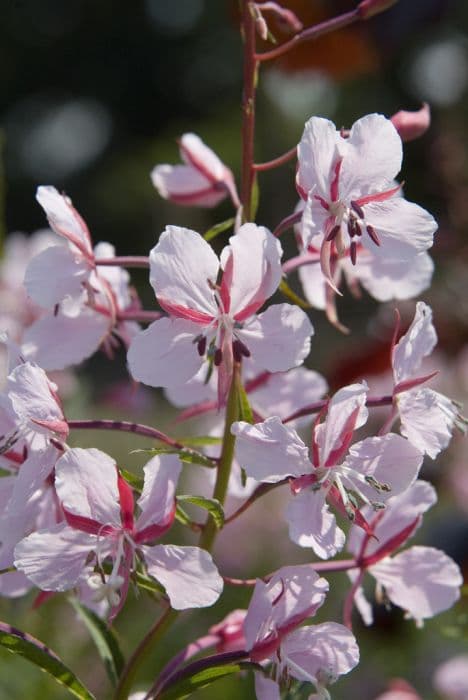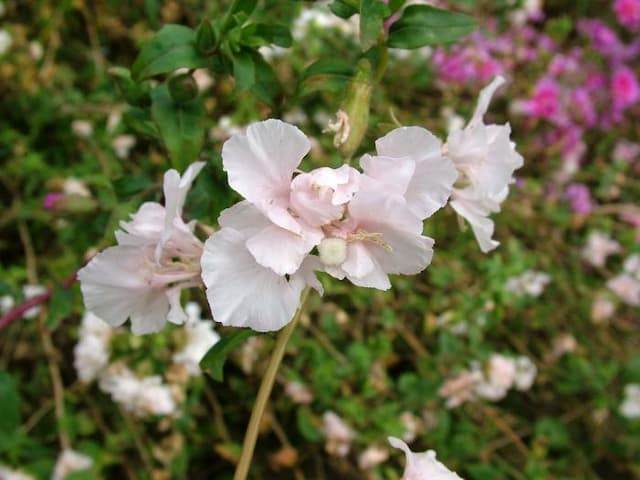Evening primrose Oenothera biennis






ABOUT
The common evening primrose has a rosette of leaves at the base, from which emerge one or several flower spikes. The leaves are lance-shaped, with a slightly wavy edge and a noticeable central vein. They are arranged alternately along the stems, giving the plant a bushy appearance. The stems themselves are often reddish and may have fine hairs. The plant is well-known for its bright yellow flowers that have a delicate, yet slightly frilly appearance. Each flower has four broad petals that spread out from a cross-shaped stigma in the center. The blooms are arranged in a loose spike and open in the evening, which is why it gets its name. The common evening primrose also bears fruits that are small, dry capsules containing many tiny seeds. These capsules are held on the stem above the foliage and can easily release the seeds when they mature. Overall, the appearance of the common evening primrose is quite distinctive, with its bright yellow flowers that stand out against the green foliage.
About this plant
 Names
NamesFamily
Onagraceae.
Synonyms
Evening Primrose, Common Evening Primrose, Evening Star, Suncups, Sun Drop, Weedy Evening Primrose, Night Willowherb, Fever Plant.
Common names
Onagra biennis, Oenothera muricata, Oenothera chicaginensis, Oenothera cruciata, Oenothera pycnocarpa, Oenothera suaveolens.
 Toxicity
ToxicityTo humans
Commonly known as evening primrose, Oenothera biennis is not considered toxic to humans. In fact, various parts of the plant, such as the seeds, leaves, and roots, have been used for culinary and medicinal purposes. Evening primrose oil, derived from the seeds, is popular for its purported health benefits. However, like with any plant, individual allergies or sensitivities can occur, and consuming it in excessive amounts could lead to adverse effects such as nausea, stomach upset, or headache.
To pets
Evening primrose is not typically listed as toxic to pets. It is generally considered safe for animals, and the risk of poisoning from ingestion is low. However, as pets might have different sensitivities, it's always wise to monitor for any signs of gastrointestinal upset or allergic reactions if they consume any part of the evening primrose plant. If any concerning symptoms do arise, it would be best to consult with a veterinarian.
 Characteristics
CharacteristicsLife cycle
Biennials
Foliage type
Deciduous
Color of leaves
Green
Flower color
Yellow
Height
3-5 feet (0.9-1.5 meters)
Spread
1-2 feet (0.3-0.6 meters)
Plant type
Herb
Hardiness zones
2-9
Native area
North America
Benefits
 General Benefits
General Benefits- Attracts pollinators: Evening Primrose is known for its ability to attract bees and other pollinators, which is crucial for maintaining healthy ecosystems and food production.
- Supports local wildlife: The seeds of Evening Primrose provide food for birds and other wildlife, supporting biodiversity.
- Low maintenance: It is a hardy plant that requires minimal care once established, making it suitable for sustainable landscaping.
- Drought resistant: Evening Primrose is known for its ability to tolerate dry conditions, which is beneficial in regions prone to drought.
- Erosion control: The plant’s root system helps stabilize soil, preventing erosion in areas where it grows.
- Edible parts: While excluding medicinal properties, some parts of the Evening Primrose are edible and utilized in culinary applications, such as the roots and young shoots.
- Ornamental uses: Evening Primrose has attractive yellow flowers that can enhance the beauty of gardens and landscapes.
 Medical Properties
Medical Properties- Anti-inflammatory: Oenothera biennis, commonly known as Evening Primrose, has been used for its potential to reduce inflammation.
- Skin health: It contains gamma-linolenic acid (GLA), an omega-6 fatty acid that may benefit skin conditions like eczema.
- Women's health: Evening Primrose oil has been traditionally used for menstrual and menopausal symptoms.
- Nerve pain: It’s been investigated for its potential in easing neuropathic pain, although research is still inconclusive.
- Anti-oxidant: The plant contains phenolic compounds that may have antioxidant properties.
- Cardiovascular health: There is some evidence suggesting it could help lower blood cholesterol levels.
 Air-purifying Qualities
Air-purifying QualitiesThis plant is not specifically known for air purifying qualities.
 Other Uses
Other Uses- Oenothera biennis, commonly known as evening primrose, has seeds that can be pressed to produce evening primrose oil, which is used in gourmet cooking as a salad dressing or for sautéing due to its subtly nutty flavor.
- The roots of the evening primrose can be eaten as a vegetable, either boiled or fried, and they have a peppery taste similar to radishes.
- The young shoots of evening primrose are edible as well and can be added to salads or cooked as greens, adding a mild, sweet flavor to dishes.
- Evening primrose flowers are edible and can be used to garnish salads or desserts, providing a sweet taste and a splash of yellow color.
- When evening primrose stems are dried, they can be used as a fiber source for making paper or crafting materials, due to their strength and flexibility.
- The plant has been used to create a natural dye, which can be extracted from various parts of the plant, providing colors ranging from yellow to green for textiles.
- Evening primrose can be planted as an ornamental garden plant due to its bright yellow flowers which bloom in the evening and are visually appealing.
- The nectar-rich flowers of the evening primrose attract pollinators like bees and moths, making it a beneficial plant for supporting local ecosystems and gardening for wildlife.
- Some traditional uses involved using the evening primrose plant to create infusions for ceremonial or spiritual bathing practices, though this is not common in modern times.
- Evening primrose oil is sometimes used in natural wood finishing to condition and protect wood surfaces without the use of synthetic chemicals.
Interesting Facts
 Feng Shui
Feng ShuiThe Evening Primrose is not used in Feng Shui practice.
 Zodiac Sign Compitability
Zodiac Sign CompitabilityThe Evening Primrose is not used in astrology practice.
 Plant Symbolism
Plant Symbolism- Resilience: Oenothera biennis, commonly known as Evening Primrose, often symbolizes resilience because it can thrive in tough environmental conditions and bounce back after disturbances.
- Healing: With its traditional uses in herbal medicine to treat a variety of ailments, Evening Primrose is often associated with healing and the soothing of wounds, both physical and emotional.
- Patience: This plant unfolds its delicate blossoms in the evening, hence its name. This act of waiting for the right moment is reflective of patience.
- New Beginnings: As the Evening Primrose can reseed itself and emerge in new places, it can symbolize new beginnings or starting afresh.
- Peace: The flower's gentle appearance and its tendency to open at dusk—a quiet time of day—can represent peace and tranquility.
 Water
WaterThe common Evening Primrose requires moderate watering; it's vital to keep the soil moist but not waterlogged. During its growing season in the spring and summer, watering once a week with roughly 1 to 2 gallons per plant should suffice, depending on the weather and soil drainage. In hotter, dryer periods, you may need to water twice a week, but always check the soil moisture first. In the winter, reduce watering frequency, allowing the soil to dry out slightly between waterings. Overwatering can lead to root rot, so it's essential to ensure good drainage.
 Light
LightEvening Primrose flourishes in full sun exposure, so it's best to plant it in a spot where it can receive at least 6 to 8 hours of direct sunlight daily. The optimal location would be an open area without shade from buildings or trees. The plant can tolerate partial shade, but the flowering might be less abundant.
 Temperature
TemperatureEvening Primrose can survive a broad range of temperatures but grows best when the temperature is between 50 and 70 degrees Fahrenheit. It can withstand minimum temperatures down to 20 degrees Fahrenheit, making it suitable for growing in USDA hardiness zones 4 to 9. The plant is fairly tolerant of heat but may require additional watering during particularly hot weather to prevent stress.
 Pruning
PruningEvening Primrose benefits from light pruning to remove spent flowers and encourage further blooming. Deadheading, or cutting off the faded flowers, can be done throughout the flowering season to maintain its appearance. Pruning back the foliage after flowering encourages new growth. The best time for heavier pruning is in the late winter or early spring, before new growth begins.
 Cleaning
CleaningAs needed
 Soil
SoilEvening Primrose thrives in well-draining soil with a slightly acidic to neutral pH between 5.5 and 7.0. A mix comprising loamy garden soil, sand, and compost will ensure proper nutrition and drainage.
 Repotting
RepottingEvening Primrose is biennial and does not typically require repotting as it dies after flowering in its second year, but you can sow fresh seeds annually.
 Humidity & Misting
Humidity & MistingEvening Primrose prefers moderate ambient humidity but is quite adaptable and can tolerate lower humidity levels without needing special care.
 Suitable locations
Suitable locationsIndoor
Plant Evening Primrose in a sunny spot with well-draining soil mix.
Outdoor
Sow seeds in sunny area with well-draining soil; tolerates drought.
Hardiness zone
3-9 USDA
 Life cycle
Life cycleThe common evening primrose (Oenothera biennis) starts its life as a seed, which germinates in early summer to produce a small rosette of leaves close to the ground. This basal rosette stage, where the plant remains throughout the first year, is a phase of vegetative growth. During the second year, the plant begins its reproductive stage, sending up a flowering stalk that can reach up a height of up to 5 feet. The plant blooms from late spring to late summer, with yellow flowers that open in the evening and close by the next noon. Once pollination occurs, usually by night-flying insects like moths, the plant produces seeds contained in capsules. After releasing its seeds, the common evening primrose completes its life cycle and dies, being a biennial plant.
 Propogation
PropogationPropogation time
Spring-Early Summer
The most popular method of propagation for the common evening primrose (Oenothera biennis) is through seeds. These plants tend to self-seed prolifically, and the seeds can be directly sown into the garden in late fall or early spring when the soil temperature is around 70 degrees Fahrenheit (approximately 21 degrees Celsius). To propagate by seeds, scatter them lightly on the surface of the soil and press them in gently. Since the seeds need light to germinate, they should not be covered with soil. Keep the soil moist but not saturated until germination, which usually occurs within 2 to 3 weeks. Evening primrose can also spread by root cuttings, but growing from seeds remains the most straightforward and commonly employed method.









